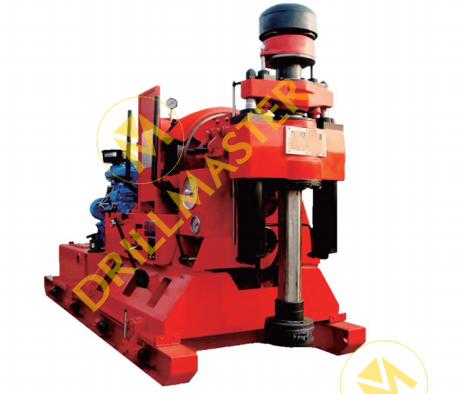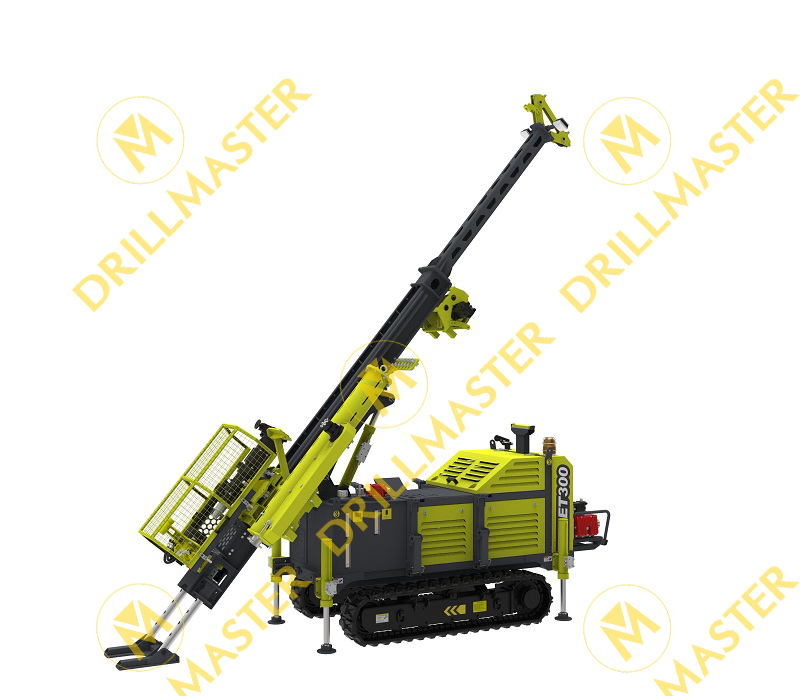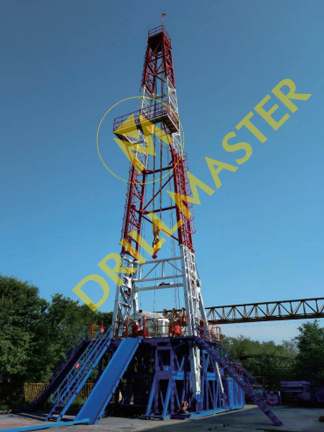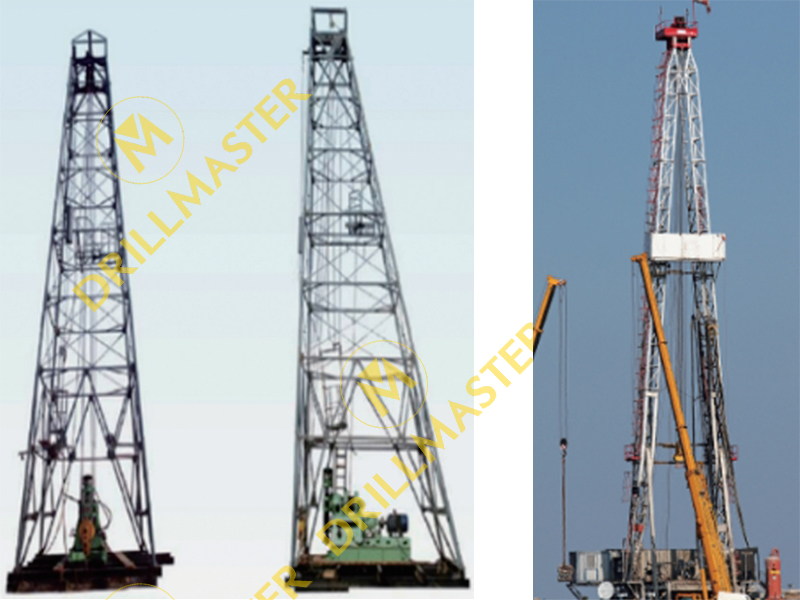E-mail: [email protected] Whatsapp: +8613647327093 Tel: +86-731-8403-0163
E-mail: [email protected] Whatsapp: +8613647327093 Tel: +86-731-8403-0163

1. Technical Principle:
Vertical shaft core drilling rigs are the longest-standing traditional drilling rig type. They primarily utilize mechanical transmission for the main drive, such as rotation and drilling tool lifting, and hydraulic transmission for auxiliary operations, such as feeding and clamping. Their primary structural feature is a vertical shaft. The operating principle is that power is transmitted to the main shaft via a belt, gears, or chain, causing the drill pipe to rotate the drill bit, thereby fracturing the formation and extracting the core. The structural principles and operating performance of various vertical shaft drilling rig models are generally similar. They are basically composed of a power source, clutch, gearbox, transfer case, gyrator, winch, hydraulic feed system, and machine base.
2. Technical Advantages of Vertical Shaft Core Drilling Rigs:
1) Simple Structure and Easy Maintenance: The mechanical transmission system is stable and reliable, easily repaired and maintained, and the accessories are highly compatible.
2) Low Cost and High Cost-Effectiveness: Suitable for small and medium-sized construction teams and projects with limited budgets. Widely applicable: Suitable for most soft to medium-hard formations, such as soil, mudstone, shale, and sandstone.
3) Flexible manual operation: Not dependent on complex control systems, suitable for use in low-power or no-power sites.
3. Typical Applications of Vertical Spindle Core Drills:
1) Engineering geological surveys (bridge, highway, tunnel foundations, etc.);
2) Agricultural water conservancy or shallow water well drilling;
3) Shallow and medium-layer mineral surveys and sampling;
4) Construction of urban geological environment monitoring holes.
4. Precautions:
1) Not suitable for drilling in high-hardness formations or at great depths;
2) Low degree of automation, resulting in high labor intensity;
3) Relatively low core integrity rate.

1. Technical Principle:
The main and auxiliary drives of a fully hydraulic core drill are hydraulic, performing main shaft rotation, thrusting, lifting, clamping, and shackle operations. Combined with advanced rope coring technology, it achieves efficient, deep drilling operations. A fully hydraulic core drill rig generally consists of a power unit, main winch, rod and feed mechanism, hydraulic system, rope winch, gripper, power source, trailer (crawler travel device), and control console. Fully hydraulic core drill rigs can be further categorized by power type as either diesel-powered or electric-powered.
2. Technical Advantages of Fully Hydraulic Core Drills:
1) High Automation and Efficiency: Centralized control at the control console allows for simultaneous execution of multiple actions, significantly improving drilling efficiency.
2) Powerful Power Output: Suitable for complex formations, particularly hard rock, highly abrasive formations, and coring at great depths.
3) High-Quality Coring Rate: Equipped with a vibration damping system and steady-speed control, it helps improve core integrity.
4) High Safety: The hydraulic system offers excellent explosion-proof performance, making it suitable for operations in hazardous or harsh environments.
5) Energy-Friendly: Some models offer diesel and electric dual-power or low-noise designs.
3. Typical Applications of Fully Hydraulic Core Drills:
1) Medium- and deep-layer metal and non-metallic mineral exploration
2) Polar expeditions, geothermal exploration, shale gas exploration
3) Geological research coring projects
4) Engineering geology deep-layer testing projects
4. Notes:
1) The equipment is relatively expensive and requires a high budget;
2) It requires professional technicians for operation and maintenance;
3) It has high requirements for hydraulic fluid and environmental cleanliness.
5. Differences between Diesel-Powered and Electric-Powered Drills:
1. Power Source and Applicable Environment
Diesel engines use diesel as fuel, powered by the engine. They are suitable for remote and off-grid areas and have high on-site adaptability.
Electric-powered engines rely on industrial electricity (typically three-phase) and are suitable for urban construction sites, mining areas, tunnels, or factories with stable power supplies.
2. Differences in Operating Performance
Diesel engines start slowly and require preheating, but they are powerful and suitable for heavy-duty, high-intensity drilling tasks.
Electric-powered engines start quickly, are responsive, and operate more smoothly, making them particularly suitable for drilling environments requiring precise control. Diesel engines are noisier when running, while electric motors are relatively quiet, making them more suitable for projects requiring noise control.
Electric motors offer higher efficiency, less heat loss, and better performance stability over long periods of operation.
3. Economy and Maintenance
Diesel engines have high operating costs, with fluctuating diesel prices. They also require regular replacement of oil, filters, and other consumable parts, resulting in frequent maintenance.
Electric motors offer lower operating costs, relatively stable electricity bills, simple routine maintenance, and a relatively longer service life.
Diesel engines have a complex system structure, requiring a high level of professional expertise for operators and maintenance personnel; electric motors, on the other hand, are more convenient to maintain.
4. Environmental Protection and Policy Compatibility
Diesel engines emit exhaust and particulate matter, which may be restricted in some cities or environmentally sensitive areas.
Electric motors are zero-emission devices, producing no exhaust during operation. They offer superior environmental performance and align with current trends in green construction.
Electric motors are significantly quieter than diesel engines and are suitable for low-noise environments such as tunnels and city centers.
5. Recommended Application Scenarios
If the drilling mission is located in remote mountainous areas, outdoor mining areas, or areas with power shortages, diesel engines are recommended for their ease of independent operation and high mobility.
If the project is located in urban construction, industrial parks, tunnel projects, or areas with reliable power supply, electric motors are recommended for their energy-saving, environmentally friendly, and economical operation.
For long-term construction projects, electric motors are preferred to reduce long-term operation and maintenance costs; however, short-term, mobile operations are more suitable for diesel engines.

1. Technical Principle:
An electric top drive core drill rig uses an electric top drive to electrically drive rotation, feed, and lift functions for core drilling. It is referred to as an electric top drive drill rig. The top drive system is the core component of an electric top drive core drill rig, providing comprehensive functions for core drilling operations, including drill pipe rotation, mud circulation, single rod connection, stand tripping, and thread removal. An electric top drive core drill rig consists of a parallel guide rail structure, a high-speed electric top drive system, a drill hoisting and feeding system, a rope winch, a circulation system, an electrical control room, a driller's room, and a wellhead assembly.
2. Technical Advantages of Electric Top Drive Core Drill Rigs:
1) Environmentally friendly and energy-efficient: Utilizing an advanced electronic control system reduces fuel consumption and noise pollution.
2) High torque, suitable for deep hole operations: Particularly suitable for large-diameter, deep holes, or hard rock formations.
3) High safety: Equipped with intelligent overload protection, an electronically controlled braking system, and remote control.
4) Automated operation: Features include automatic drilling, data acquisition, online core analysis, and support for digital platform integration.
3. Typical Applications of Electric Top Drive Core Drills:
1) Deep-hole core sampling operations in large mining areas
2) Geothermal exploration, carbon sequestration projects (CCS), shale gas drilling
3) Core analysis and sampling in scientific research institutions
4) Automated, unattended drilling tasks
4. Notes:
1) High equipment procurement and transportation costs;
2) High power supply system requirements (usually requiring three-phase power or an independent power station);
3) Daily inspection and commissioning by technical engineers are required.

1. Definition and Function:
The drilling mast is a key component of drilling equipment. Its primary function is to suspend the crown block, traveling block, hook, and hoist, and is used for tripping and lowering drilling equipment, storing drill pipe, and suspending drilling tools. The drilling mast is not the main drilling rig itself, but rather a platform system that provides support for drilling operations. Drilling towers are generally categorized by structure, including square, A-shaped, triangular, and mast towers. Vertical-spindle core drilling rigs typically use square or A-shaped towers, while fully hydraulic core drilling rigs use mast towers.
A square derrick is a four-sided pyramidal derrick with an enclosed truss structure. It offers ample internal operating space, can be equipped with a tower cover, and features front and rear yards, providing excellent load-bearing and stability. An A-shaped derrick is a two-corner derrick constructed from a small-section truss structure. It features an integrated lifting and removal mechanism, is lightweight, and offers ample operating space for its travel system, providing the driller with a wide field of view. A mast derrick is typically a monolithic columnar structure consisting of a mast and tower. It is integrated with the drilling rig and other mechanical equipment. The drilling rig's lifting system, pressure-increasing and pressure-reducing drilling system, and other components are centrally mounted on the mast, enabling hydraulic lifting and lowering, making it easy to use and highly efficient.
2. Structure:
1) Integral (Fixed): Commonly used for large-scale, long-term drilling projects, offering excellent stability.
2) Foldable (Mobile): Suitable for portable or small-scale drilling, easy to disassemble and transport.
3) Mast: Lightweight, suitable for use with shallow-hole or portable drilling rigs.
3. Technical Advantages of Drilling Masts:
1) Efficient Hoisting System: Supports coordinated operation of pulleys, winches, hooks, and other equipment.
2) Improved Operational Efficiency: Facilitates continuous footage and core lifting, suitable for deep-hole drilling.
3) Enhanced Safety: Eliminates the risks of manually extracting heavy drilling tools.
4) Capable of accommodating a variety of drilling rig systems: hydraulic drills, top-drive drills, and deep-well drills.
4. Typical Applications of Drilling Masts:
1) Medium- to deep-seated core sampling projects
2) Large-scale mineral exploration, oil and gas drilling
3) Geothermal development, carbon sequestration projects
4) Drilling operations in unusual terrains, such as plateaus, deserts, and offshore areas.
5. Precautions:
1) Installation requires specialized lifting equipment.
2) Height is subject to transportation and site restrictions.
3) Structural compatibility design is required for integration with different drilling rigs.
Contact Us
